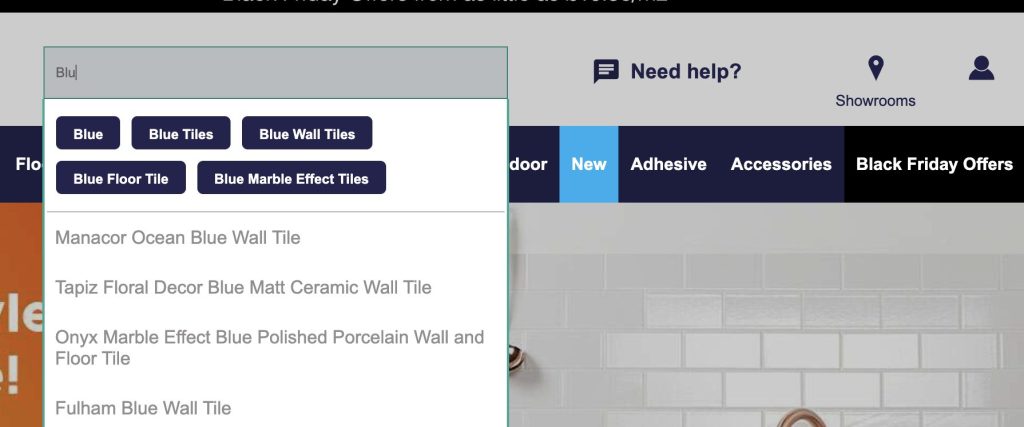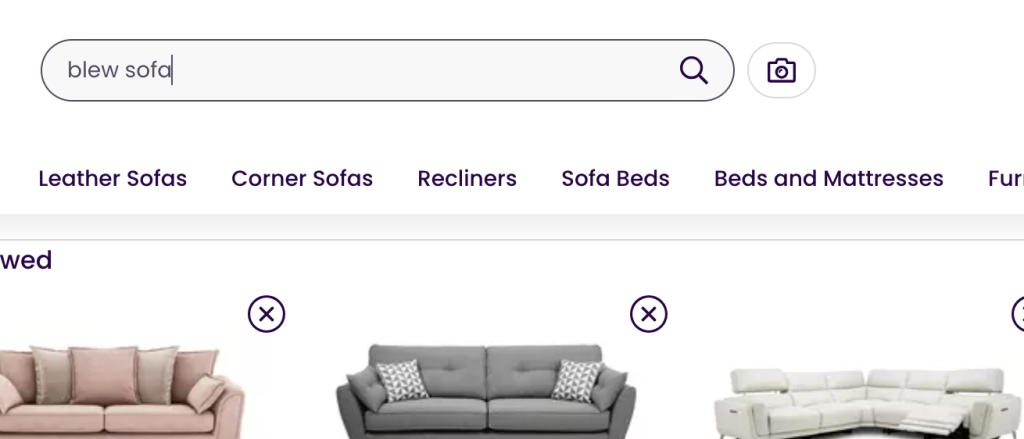Onsite search is one of your best tools to support a seamless customer journey. Yet 94% of consumers report they’ve received irrelevant search results (Google Cloud). In our experience, we’ve also found a lot of brands feel their search is working fine, but when tested, critically underperforms. When auditing the top 50 Home and Furniture brands in the UK, we found that 62% underperformed when we tested their search functionality.
The good news is that there are easy and effective fixes that can transform your onsite search into a powerful tool for customer satisfaction and increased sales.
Statistics show that improving search algorithms can significantly impact user satisfaction. Amazon’s conversion rate shoots up when visitors search from 2% to 12%. That’s a whopping 6 times higher than if they just visit the site.
Many off-the-shelf e-commerce platforms come with basic search functionality that may not meet the specific needs of your home and furniture store. Consider investing in search solutions that offer advanced features like natural language processing, synonym recognition, and typo-tolerance to improve search accuracy and relevance.
 Implementing auto-suggestions is essential for creating a superior onsite search experience. By offering real-time suggestions as users type in the search bar, this feature not only saves time but also significantly enhances user efficiency. The immediacy of suggestions promotes a seamless search process, increasing the likelihood of users finding what they need without frustration.
Implementing auto-suggestions is essential for creating a superior onsite search experience. By offering real-time suggestions as users type in the search bar, this feature not only saves time but also significantly enhances user efficiency. The immediacy of suggestions promotes a seamless search process, increasing the likelihood of users finding what they need without frustration.
Moreover, auto-suggestions contribute to product discoverability, exposing users to items they may not have been initially aware of, thereby opening avenues for cross-selling or upselling. For optimal effectiveness, it’s crucial that the auto-suggestions are responsive, providing accurate and relevant results.
Integrating personalisation based on user history and preferences, along with ongoing optimisation through analytics, ensures that the system evolves with user behaviour. This user-centric approach, coupled with mobile-friendly design, results in a continuously improved onsite search that aligns with user expectations and contributes to a positive overall online shopping experience.
Customers expect robust filter and sort options, especially with larger sites. Filters allow for granular customisation, enabling users to narrow down results by criteria such as price, style, colour, material, and other pertinent attributes. This level of customisation not only streamlines the search process but also empowers customers to find precisely what they’re looking for. Intuitive sorting features further augment the user experience, allowing products to be arranged according to individual preferences, whether it’s by price, popularity, or customer ratings.
This functionality ensures that customers can easily locate products that align with their priorities, promoting a seamless and personalised shopping journey. By implementing comprehensive filter and sort options, businesses can cater to diverse customer needs and deliver a more refined and satisfying online shopping experience.

In 2022, Adobe reported that based on the growth* in mobile purchases made last year, it expects mobile shopping will pass desktop between 2023/24 for the Home and Furnishings Industry.
Given the prevalence of mobile shopping, it’s critical to provide a seamless mobile search experience. Optimise your search for mobile users with responsive design and user-friendly touch controls. Make sure to continue testing this as your site grows and evolves.
Artificial intelligence and machine learning can play a significant role in enhancing onsite search. It will help your marketing team to analyse user behaviour, track preferences, and continually improve search results based on past interactions.
These technologies can discern patterns, understand user intent, and adapt search algorithms in real-time. Through continuous learning from past interactions, AI algorithms refine and optimize search results, ensuring that users receive more accurate and relevant information with each query.
Consider employing AI-driven personalisation to offer relevant product recommendations to customers, effectively handle errors and make suggestions based on data collected from other customers.
 Your website should still be able to facilitate customers’ needs even when they make errors. Think typos or ambiguous queries that we expect shoppers to make. With user-friendly error handling, businesses can actively guide users toward accurate search results for a smoother and more satisfying user journey. You’re also likely to inspire additional product searches by showing similar ranges, increasing your buyer’s likelihood to remain on site and purchase.
Your website should still be able to facilitate customers’ needs even when they make errors. Think typos or ambiguous queries that we expect shoppers to make. With user-friendly error handling, businesses can actively guide users toward accurate search results for a smoother and more satisfying user journey. You’re also likely to inspire additional product searches by showing similar ranges, increasing your buyer’s likelihood to remain on site and purchase.
Start by testing your current onsite search with intentional mistakes to see how well your search tool can handle these errors.
Mistyped search queries are common. Ensure that your system can handle errors gracefully by providing suggestions or alternatives to help users find what they are looking for, even if they make typos. During our audit of the top 50 UK Home and Furniture brands, we found that 50% were not able to handle these errors effectively.
Don’t underestimate the power of feedback. Encourage customers to provide input on your onsite search experience. Understand their pain points and preferences, and use their feedback to drive improvements.
Your onsite search doesn’t have to suck. By implementing these easy fixes, backed by industry-specific statistics, you can create an efficient and user-friendly search experience for your home and furniture retail store. A well-optimized onsite search not only leads to satisfied customers but can also drive increased sales and customer loyalty. Make these improvements, and watch your search functionality become a powerful tool in your e-commerce arsenal.
Partnering with a reputable Sitecore agency or Sitecore partners like Sagittarius ensures a smooth implementation and a platform tailored to your specific needs, including understanding Sitecore Pricing for your brand. Contact us for a bespoke quote.
Find out the e-commerce effectiveness of the top 50 UK Home retailers and how they compare.